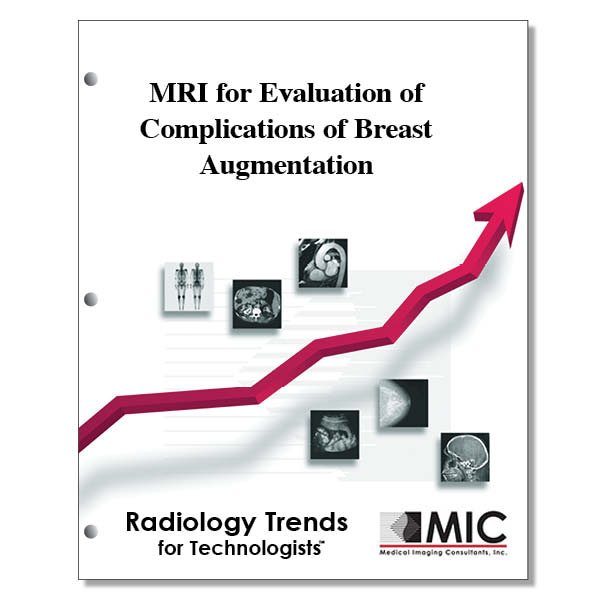

MRI for Evaluation of Complications of Breast Augmentation
With breast augmentation being one of the most popular cosmetic surgical procedures worldwide, this is a review of breast implants, their placement, their complications and the role MRI plays in evaluating implant integrity and clarifying the findings of conventional imaging when equivocal.
Course ID: Q00719 Category: Radiology Trends for Technologists Modalities: Mammography, MRI2.75 |
Satisfaction Guarantee |
$29.00
- Targeted CE
- Outline
- Objectives
Targeted CE per ARRT’s Discipline, Category, and Subcategory classification:
[Note: Discipline-specific Targeted CE credits may be less than the total Category A credits approved for this course.]
Breast Sonography: 1.00
Procedures: 1.00
Breast Interventions: 1.00
Mammography: 1.00
Procedures: 1.00
Mammographic Positioning, Special Needs, and Imaging Procedures: 1.00
Magnetic Resonance Imaging: 2.00
Procedures: 2.00
Body: 2.00
Registered Radiologist Assistant: 2.00
Procedures: 2.00
Thoracic Section: 2.00
Sonography: 1.00
Procedures: 1.00
Superficial Structures and Other Sonographic Procedures: 1.00
Outline
- Introduction
- Breast Implant Classification
- Implant Type
- Implant Lumen
- Implant Texture
- Implant Location
- MRI Evaluation of the Augmented Breast and Recommended Protocol
- Normal Findings at MRI of Patients with Breast Implants
- Radial Folds
- Peri-Implant Fluid
- Complications of Breast Implants
- Peri-Implant Collections
- Capsular Contracture
- Implant Rupture
- Deformities, Displacement, and Malposition of the Implant
- Desmoid Tumors
- Breast Implant-Associated Lymphoma
- Fat Necrosis
- Silicone Injection
- Breast Cancer in Patients with Implants
- Conclusion
Objectives
Upon completion of this course, students will:
- know the current percentage of saline vs. silicone breast implants
- recognize the greatest complication for breast implants as they age
- realize the nature of a breast implant rupture
- understand why MRI is the imaging modality of choice to evaluate the integrity of breast implants
- know how current, 5th generation breast implants compare to earlier designs
- identify the substances used to fill single lumen breast implants
- recognize characteristics associated with textured implants
- understand the possible locations for a breast implant in relation to the pectoralis muscle
- realize that the placement of the implant impacts the ease with which the implant can be displaced for a mammography study
- learn about signal suppression with MRI pulse sequences
- identify pulse sequences in a breast MRI exam for a patient who has breast implants
- recognize proper MR imaging parameters for a breast exam
- recognize when intravenous gadolinium-based contrast material should be used in a breast MRI exam
- identify normal findings on breast MR images
- recognize how to differentiate radial folds from implant rupture on breast MRI
- know the approximate lifespan of breast implants
- identify local complications of breast implants
- learn the MR imaging features suggestive of infection
- know about capsular contracture
- understand where free silicone is found with different types of implant rupture
- register the percentage of breast implants that rupture within 10 years
- know the term used for saline implants that have leaked
- recognize the imaging modality with the highest sensitivity for determination of implant rupture
- realize where silicone may migrate in extracapsular ruptures
- recognize definitive signs of rupture seen at MRI
- know the most reliable sign to diagnose extracapsular rupture
- know another name for desmoid tumor
- learn about breast implant-associated anaplastic large cell lymphoma
- recognize a benign inflammatory process that occurs as a result of vascular compromise to adipose tissue
- understand why mammography is less sensitive to identifying breast cancer in patients with breast implants
